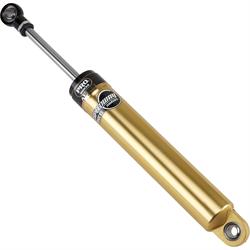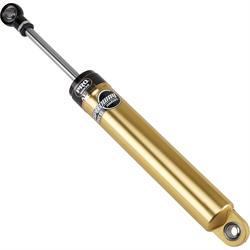General Sprint Car Shock Technology
Shocks are one of the main parts of the suspension on a sprint car. Things have changed from the days where you could go to an auto parts store and buy a shock to bolt onto your race car. Now, most teams have shocks custom tuned to their specs and what works for them. Your driving style, the feel you like to have in the car, and a number of other factors will play into where you want your shocks set. Here, we will take a little bit deeper look into Sprint Car shocks.
First off, if you are buying a shock off of the shelf, there are some things that you will want to remember. Pro, AFCO, QA1, as well as others still do offer shocks that are labeled with a standard valving. The valving number will be stamped under the body of the shock, as shown in the picture to the right. One thing to remember though is while you may have three shocks sitting in front of you that are labeled the same, they may not all be the same. This is why most shock manufacturers now provide dyno sheets for their shocks.
Out of three straight 5 Right Rear Pro shocks, they may all have slight variances. Say for example that a Pro 5 valve is about 80 pounds on your 3 inch number. Out of those three you may find that one has a compression of 75, one has a compression of 83, and one has a compression of 90. Same goes for the rebound side, so you could end up with a shock that has a compression of 75 and a rebound of 90, which would be a very slight tie down, even though it is still labeled as a straight 5 valving. For this reason, it is always a good Idea to get your shocks dyno tested to know what you truly have.
Now that were talking about dyno numbers, it would help to know how to read a dyno sheet. Above is a picture of your typical dyno sheet. The dyno sheets that Speedway Shock Technologies produces will have your Compression number on the top half of the graph (positive numbers) and your rebound number will be on the lower half of the graph (negative numbers). At the bottom of the graph, you will have your speed. Shocks are dyno tested at inches per second, so the 1 mark is the shock moving at 1” per second, 2 will be 2” per second, and so on.
The most important numbers you will look at will be your 1 and 3 inch numbers, which will be the two velocities that are the most important in a sprint car. The 1” velocity will be the number in which the driver feels, and the 3” velocity will be the number that you are able to see from the pits. On this particular graph, you can see that the compression at the 3 inch number is actually stiffer than the rebound by about 50 pounds, making this a slight easy up shock. Once you start to do a little bit of testing with different rates and such on your race car, the driver will be able to tell you what changes are making the car better, or worse, and you are able to typically work with your shock builder to build a package that works for your combination.
Easy Up shocks are shocks where the compression is stiffer than the rebound. A slight easy up shock is a good shock to use on the Right rear of the car when the track is heavy. An extreme easy up shock is typically used on the Right Front Corner of the car when the track is very slick. Tie Down shocks are mostly used on the left side of the car in a Winged application. You will typically use an extreme tie down on the Left rear to keep the left side down, and a slight tie down on the left front to start the night on a heavy or tacky race track.
Baseline Dyno Numbers for an Average or Tacky Track:
- RR: 5-5
- LR: 4-8 Or possibly a 3-8
- RF: 5-5
- LF: 4-6
As the night goes on and the track starts to get slick, the general changes that will be made will be letting the fronts come up, and going to something like a 5-3 or a 5-2 on the right front, and a 4-4 or a 5-4 on the left front. You may also go with a shock like a 5-6 on the right rear when the track gets slick, as well as letting the Left Rear come up a little bit easier and going to something like a 4-7. All of this will help the car get over on the right rear more promoting side bite when the track gets slick.
Bump Rubbers are another thing that can help in tuning your race car. On a Winged Car, bump rubbers are mostly used on the Left Rear Corner of the car, however some teams utilize them on the Right Rear shock as well. Basically they will limit the down travel of the shock.
One of the biggest issues that people will face when they are not running them, is they will unload the Right Rear tire. The farther the car dips to the left, the lighter the Right Rear corner of the car becomes. On a smaller race track you will want to have about 3 inches of Left Rear Shock travel, and once the shock travels the 3 inches it will contact the bump rubber. This will help keep the Right Rear loaded on corner entry. On a larger track (3/8” or bigger) you will want to close that gap up to about 2.5” of travel. Additionally, you can add packers when the track gets slick to close it up from your baseline. From a tacky to a slick track though, you really do not want to close the gap up more than ¼ inch or so.
If you have any further questions, please feel free to give our Sprint Car Specialists or Speedway Shock Technologies a call, and we would be more than happy to help you!



